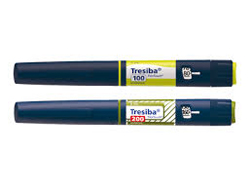 |
| Novo Nordisk R&D head Mads Krogsgaard Thomsen |
Novo Nordisk has its Tresiba approval in the bag, and big ambitions for using it to capture a bigger share of the basal insulin market. But the Danish drugmaker sees another med--the combo drug Xultophy--as an equally potent tool for the same job.
Novo announced Tresiba's approval Friday, alongside a Tresiba-plus-metformin combination dubbed Ryzodeg. To cap it off, the company said it had submitted Xultophy to the FDA, putting the Tresiba-plus-Victoza cocktail en route to a potential approval next year.
"I think you can expect as much of Xultophy as of Tresiba," Novo R&D chief Mads Krogsgaard Thomsen told the Danish publication Jydske Vestkysten, saying that the combo product has some of the strongest late-stage data he's ever seen. "If not the strongest," he said.
Sydbank analysts have pegged peak sales of Tresiba at 17 billion Danish crowns, or about $3 billion. Novo ($NVO) hasn't set out its own estimates. But with such strong hopes for Xultophy, it's doubly important for Tresiba to hit its stride. Establishing a strong rep for Tresiba with doctors can only boost uptake of Xultophy when the time comes, Thomsen said.
Essentially, Novo wants doctors to see Tresiba as "the preferred basal insulin, like Victoza is the preferred GLP-1," Thomsen said, because if that's the case, doctors will see the combination med and think, '[I]t must be good.' "
 To that end, the company has been preparing for Tresiba's launch--well, for years now, given the fact that it was ready to go in December 2013, when the FDA first rejected the drug. The company has a legion of reps to take on the promotional task, and a dosing advantage it can tout. The drug's long-lasting effects mean it can be taken any time of day, the company says, which makes complying with treatment easier.
To that end, the company has been preparing for Tresiba's launch--well, for years now, given the fact that it was ready to go in December 2013, when the FDA first rejected the drug. The company has a legion of reps to take on the promotional task, and a dosing advantage it can tout. The drug's long-lasting effects mean it can be taken any time of day, the company says, which makes complying with treatment easier.
The company had been hoping for an FDA label that allowed it to promote another Tresiba advantage--a lower risk of hypoglycemia. "It's one of the things diabetics fear most, and Novo has shown in various studies that it is a more stable insulin than others," Sydbank analyst Søren Løntoft told Politiken, adding that he sees it as crucial for Novo to persuade the FDA to add the advantage to Tresiba's labeling.
The drug's European approval includes that edge, but the FDA approval doesn't. That was a disappointment, not only because Novo can't trumpet the data to U.S. doctors or patients, but that it can't be used in negotiations with payers, Løntoft said.
And formulary negotiations are going to be a deciding factor for Tresiba, Novo CEO Lars Rebien Sørensen has said. During the company's Q2 earnings call, Sørensen said payer coverage will probably determine which basal insulin grabs the most market share. With Sanofi's ($SNY) Toujeo launch underway, it will be a head-to-head battle for formulary placement.
And thanks to a patent settlement between Eli Lilly ($LLY) and Sanofi, the two new basal insulins will have a chance to compete all next year without the added worry of a biosimilar version of Sanofi's dominant basal insulin, Lantus. Sanofi and Lilly agreed to a launch for the latter's biosim in mid-December 2016.
For Novo, it's an opportunity to finally make inroads in a market where it's historically fallen short. The company's current basal insulin, Levemir, has only managed to snag about 25% of the U.S. market, Thomsen says. That makes Tresiba and Ryzodeg--and hopefully, Xultophy--"super important" to the company's goal of grabbing at least half.
- see the Jydske Vestkysten piece
- get more from Politiken